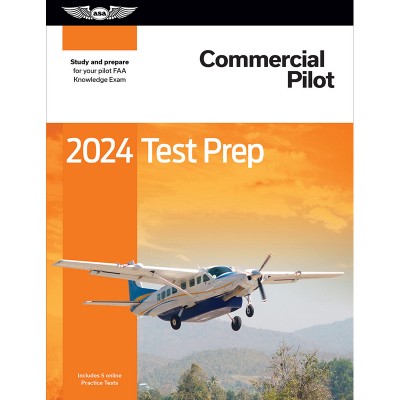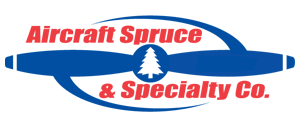- Back All Categories
- Airframe Parts
- Back Airframe Parts

- Photo may represent series and not specific product
- SHARE
ASA Test Prep 2024: Commercial Pilot
Select Format:
Add to Cart Softcover Book
Softcover Book  Test Guide Plus Prepware
Test Guide Plus Prepware  Prepware
Prepware
FREE Shipping Item qualifies for free outbound shipping. Please note other excluded items on the same order may incur a freight charge. Free shipping must be selected in cart for promotion to apply.

Eligible for Flat Rate Shipping Item qualifies for flat rate outbound shipping. Please note other excluded items on the same order may incur a freight charge. Flat Rate Shipping must be selected in cart for promotion to apply.

30 Day Risk Free Purchase
FREE Shipping + Returns Item qualifies for free outbound and return shipping. Please note other excluded items on the same order may incur a freight charge. Free shipping must be selected in cart for promotion to apply.
30 Day Risk Free Purchase
Flat Rate Shipping + FREE Returns Item qualifies for flat rate outbound and free return shipping. Please note other excluded items on the same order may incur a freight charge. Flat rate shipping must be selected in cart for promotion to apply. Flat rate shipping will not be reimbursed if item is returned.
30 Day Risk Free Purchase
Eligible for FREE Return Shipping Item qualifies for free outbound and return shipping. Please note other excluded items on the same order may incur a freight charge. Free shipping must be selected in cart for promotion to apply.Overview
Study questions for the Commercial Pilot and Military Competency FAA Knowledge exams, supported with answers and explanations. Includes softcover book, FAA testing figures and diagrams, and 5 practice tests at prepware.com!
Rely on the time-proven and dependable ASA Commercial Pilot Test Prep to prepare for your FAA Knowledge Exam. Test material is expertly organized into chapters based on subject matter and includes introductory text and illustrations, questions, answer choices, answers, explanations (for correct and incorrect answers), and references for further study. This topical study promotes understanding and aids recall to provide an efficient study guide. When you�re done studying, take practice tests and receive your test authorization (endorsement) with ASA�s online simulated testing program at no additional cost!
The ASA Test Prep includes the figures, legends, and full-color charts from the FAA Airman Knowledge Testing Supplement so you�ll be familiar with the information you�ll be issued at the testing center. You can count on ASA to provide you with the latest changes in the FAA Knowledge Exams through a free email subscription service and updates. ASA�s Commercial Pilot Test Prep is the pilot�s best resource for successful test-taking.
Use Test Prep 2023: Commercial Pilot for the following Knowledge Exams:
- Commercial Pilot - Airplane
- Commercial Pilot - Helicopter
- Commercial Pilot - Gyroplane
- Commercial Pilot - Glider
- Commercial Pilot - Balloon - Hot Air
- Commercial Pilot - Airship
- Commercial Pilot - Balloon - Gas
- Military Competency - Airplane
- Military Competency - Helicopter
- Commercial Pilot - Canadian Conversion
Features
- Questions for all Commercial Pilot and Military Competency FAA Knowledge Exams: airplane, rotorcraft, glider, and lighter-than-air
- Explanations for correct and incorrect answers, FAA references for further study, and airman test report codes for remedial study
- Figures from the FAA Airman Knowledge Testing Supplement
- Organization by subject with introductory text for efficient and logical study
- Commercial Pilot Certificate requirements
- 5 free online practice tests and test authorization
- Test-taking tips and quick cross-references for easy question-finding
- Free online updates and subscription service to stay informed of test changes
Specifications
- Edition: 2024
- Effective Date: 2023
- Page Count: 416
- Illustrations: Black and white
- Inclusions: Airman Knowledge Testing Supplement (CT-8080-1E)
- Dimensions: 8.25 x 10.75 inches
- Copyright: � 1957-2023 Aviation Supplies & Academics, Inc. All rights reserved.
- Date Published: 2023
- eBundle / eBook
- ASA eBooks are for one person's use and can be read on up to five devices total using e-reader applications that are compatible with an Adobe ID. To read eBooks on more than one device, the e-reader applications on those devices must be authorized with your Adobe ID.
- To create an Adobe ID, or to recover lost or forgotten ID information like your login or password, (Click Here)
Version Types
eBook PD - A protected document that looks identical to its print book counterpart. Exact formatting and layout of the print books is maintained (text, images, margins, page breaks, etc.). Displays best on 10-inch or larger screens. Not recommended for small screens (phones) which require you to zoom in and pan around to see the full page. This document is not a .pdf file type. It is a .acsm file type. See http://asa2fly.com/use-ebooks for more details on how to setup your device.
Softcover Book - Printed book with heavyweight cover stock.
eBook EB - A protected document designed for reflowable content. Also referred to as an ePub or "Electronic Publication" format. Easily viewed on both small and large screens. Text, images, and pages will adapt or reflow to fit the screen size of the device, so zooming is not necessary to read. Text size can be adjusted in an ebook reader app. Visit http://asa2fly.com/use-ebooks for more details on how to setup your device.
eBundle - Includes both the print book and eBook PD.
Reader Resources
- 1. The Learning Statement Code (LSC) associated with question topic areas. The Learning Statement codes currently appear on the Airman Knowledge Test Report for any missed knowledge test questions.
- 2. The �Airman Certification Standards� (ACS) code for question topic areas. The FAA expects the ACS codes to replace LSCs on the Private and Instrument Airman Knowledge Tests within the next 12 � 18 months.
Airman Certification Standards
Since September 2011, the FAA has worked closely with a diverse group of aviation community stakeholders, including ASA, who convened to help the agency improve the testing/training standards, guidance, and test development/management components of the airman certification process. The industry participants in this effort have developed the Airman Certification Standards (ACS) framework as a way to improve airman training and testing by providing an integrated, holistic system that clearly aligns airman testing with certification standards and guidance. ACS is built on the existing Practical Test Standards (PTS), which explicitly define the performance metrics for each flight proficiency element listed in 14 CFR. The ACS approach enhances the PTS by defining the specific elements, aeronautical knowledge, and risk management awareness needed to support each Area of Operation and Task.By presenting the elements of knowledge, skill, and risk management in the integrated ACS format, the ACS approach better serves the applicant, the instructor, and the evaluator. In addition, the ACS approach will enable the FAA to create and maintain a clear link between the regulations, knowledge/skill performance standards, guidance, and test materials.
The FAA has accepted the industry group�s recommendation to adopt the ACS approach and continues to work with this group to refine the ACS and plan for its eventual implementation. Current endeavors include FAA support for industry efforts to prototype the ACS approach in selected locations.
Airman Certification Standards (ACS) Codes
The overarching goal of the ACS effort is to create an integrated, coherent airman certification system in which standards, guidance, and testing can be aligned and maintained in alignment. This type of symmetry in all materials is key to fully realizing the benefits the ACS system promises to both the FAA and its many stakeholders. It is also the key to conformance with accepted industry standards for certification programs, which require that items to be trained and tested are directly linked to the job/task analysis�in this case, the ACS.To help achieve this goal, the aviation community experts who developed the ACS have also created a new coding system that will eventually apply to both Airman Knowledge Tests and Practical Test tasks. These codes provide the means to correlate the tasks in the ACS with guidance and testing and to keep them aligned going forward. When the FAA implements the ACS approach, the ACS codes will supersede the current LSC system, which has become too limited to serve as a mechanism for alignment and too complex to effectively serve the needs of the FAA and the stakeholder community.
The proposed coding system has four elements that are anchored in the ACS and not in reference documents, as are the current LSCs. Examples:
-
PA = Identifies the applicable ACS (private pilot airplane)XI = Area of Operation (Night operation)A = Task (Night preparation)K1 = Task element [knowledge (K), skill (S), risk management (R)] (1. Physiological aspects of night flying as it relates to vision)
-
IR = Identifies the applicable ACS (instrument rating)I = Area of Operation (Preflight preparation)A = Task (Pilot qualifications)K1 = Task element [knowledge (K), skill (S), risk management (R)] (1. When an instrument rating is required)